15 Types Of BLUE BIRDS In Florida (ID Guide With Photos)
Did you see a blue-colored bird in Florida? In that case you’ll probably want to know what species you saw.
To help you identify the bird you saw, we’ll cover all the types of blue birds that can be seen in Florida.
We’ll show you the birds of Florida that are either entirely or partially blue, and will also cover where you can expect to find these birds.
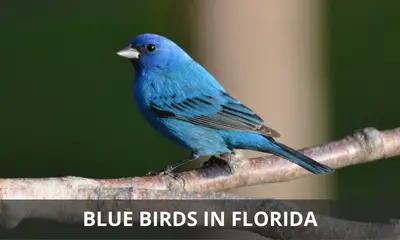
What types of birds are blue in Florida?
The 15 types of blue-colored birds found in Florida are:
- Indigo Bunting
- Florida Scrub Jay
- Eastern Bluebird
- Blue Jay
- Blue-gray Gnatcatcher
- Black-throated Blue Warbler
- Northern Parula
- Tree Swallow
- Purple Martin
- Belted Kingfisher
- Great Blue Heron
- Little Blue Heron
- Blue Grosbeak
- Blue-winged Teal
- Blue-headed Vireo
Out of these 15 birds, only one species is entirely blue (the Indigo Bunting), while the others are partially blue birds.
Now let’s dive into the details, and take a closer look at each of these birds in order to get the full scoop:
Indigo Bunting
Scientific name: Passerina cyanea
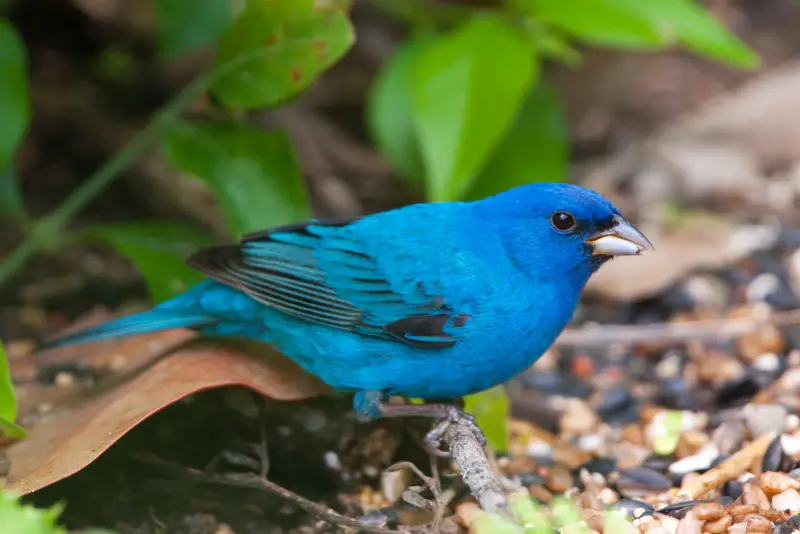
The Indigo Bunting is a brightly colored small finch. During the summer, the male is almost entirely indigo blue, except for darker brownish wingtips and tail feathers.
Females and juvenile birds are more inconspicuous, with light brown upperparts, and creamy white underparts.
The Indigo Bunting is relatively common in Florida at forest edges, gardens, and parks, and will readily visit bird feeders that offer seeds.
The Indigo Bunting is the only entirely blue-colored bird in Florida
This blue bird is most commonly seen at backyard bird feeders in spring, but not in summer, as it switches over from seeds to eating mostly insects during the summer.
During the breeding season, males of this bird can often be observed singing from a treetop perch.
This blue bird is a strict migrant, and is only found in Florida during the summer. It winters in Central and South America, and migrates in small flocks during the fall migration.
Florida Scrub Jay
Scientific name: Aphelocoma coerulescens

The Florida Scrub Jay is unfortunately a rare bird with steadily declining numbers. This trend is due to widespread habitat loss.
The upperparts of this jay are cerulean blue, except for the gray mantle streaked with brown. The forehead and throat are also gray, as is the belly.
This blue and white jay can be easily identified by its characteristic undulating flight as it flies from one group of trees to another.
It frequents open woodland habitat, especially with scrub oak populations, and feeds on insects such as ants and beetles, as well as spiders, worms, seeds and fruit.
Eastern Bluebird
Scientific name: Sialia sialis

The Eastern Bluebird is found throughout north and central Florida, where it is a year-round resident
The upperparts of adult males are a rich shade of admiral blue. This coloration also extends into their wings, tail, and the back of their heads.
The partial orange collar of males creates the impression of having a cap on their head. Males have a prominent rufous orange chest.
The upperparts of adult females have a more grayish-brown color. However, females also have a blue tail and wing feathers, as well as a rufous-orange chest and flanks.
It is a migratory bird in the northern part of its range, but can be seen year-round in Florida. Northern populations winter in Mexico.
This bird nests in holes, and competes with House Sparrows and European Starlings for nesting sites.
During their fall migration, they can be seen in flocks that like to feed on fruits and berries.
The population of Eastern Bluebirds underwent a dramatic decline at the end of last century, due to lack of nesting holes and competition with European Starlings.
But largely thanks to the efforts of numerous Florida citizens providing nest boxes for Eastern Bluebirds, these birds are a common sight in Florida once more.
While this bird species is a hole nester that originally used a Woodpecker nest cavity for its nestlings, it now readily accepts artificial nest sites for its brood.
You can attract these blue birds in Florida to your backyard by offering mealworms at your bird feeder.
Blue Jay
Scientific name: Cyanocitta cristata
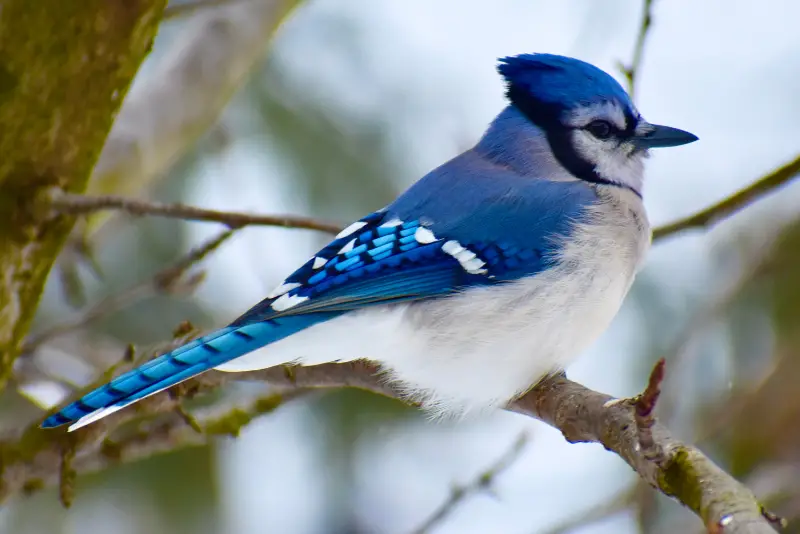
A common blue-colored bird of Florida, the Blue Jay prefers open areas with scattered trees, shrubs, and other vegetation with dense undergrowth.
These medium-sized blue birds are grayish blue on top, with bright arctic blue wing feathers and tail feathers. Their underparts are light gray.
They are social birds that live in small groups called colonies, with each colony containing one dominant pair and several subordinate members.
Dominant male birds defend their territory against intruders and aggressively chase away subordinates. Subordinate females and young birds are tolerated but not protected.
These backyard birds are opportunistic feeders. They eat fruit, invertebrates, small vertebrates, and carrion, and also steal food from other animals.
During the summer, insects make up the largest part of their diet. They sometimes catch insects in flight, while at other times, they catch insects at ground level using a variety of techniques.
These blue birds of Florida often use man made structures such as buildings, bridges, and telephone poles for foraging.
When hunting for food, jays often run along branches or wires before swooping down to capture prey.
They are partially migratory birds, but can be seen in Florida all year round. During the cold season they sometimes move around to areas with a more plentiful supply of food.
If you want to attract these birds to your bird feeder, it’s best to offer them peanuts or sunflower seeds.
Barn Swallow
Scientific name: Hirundo rustica
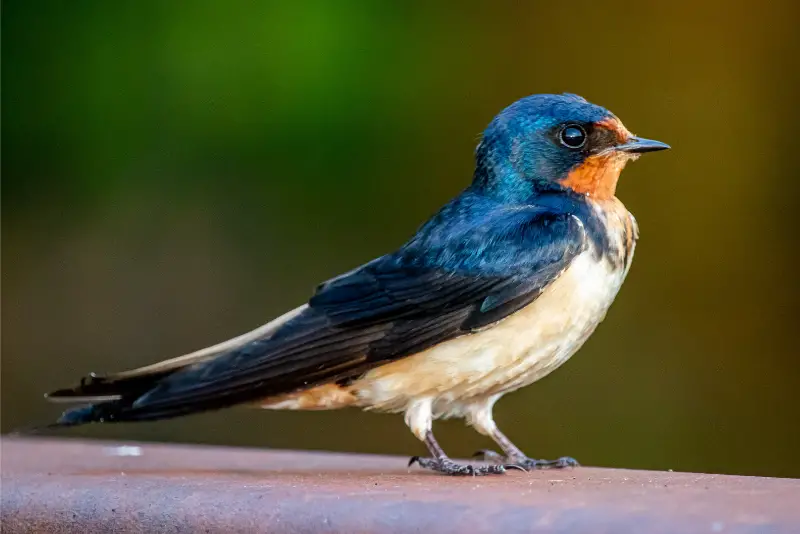
The Barn Swallow inhabits nearly all of North America south of the Arctic circle and may be found in a wide variety of habitats.
This bird has iridescent upperparts that shimmer in various shades of dark blue when the sunlight hits them.
Its underside is reddish-orange, including a chestnut orange forehead and throat, as well as a light reddish-orange belly.
The deeply forked tail of Barn Swallows is another great feature you can use to identify this bird.
However, keep in mind that immature barn swallows have a duller plumage than adults, as well as a shorter tail that is less forked.
The Barn Swallow used to nest in caves and hollow trees, but nowadays it prefers to do so beneath the overhangs of buildings and bridges, as well as inside barns (which explains how this bird got its name).
Barn Swallows are still a reasonably common sight in most areas. However, the overall numbers of Barn Swallows have been steadily decreasing, especially in the northern section of their range.
This decline is likely a result of the loss of foraging areas and nesting opportunities.
The Barn Swallow feeds on flying insects, such as mosquitoes and flies, and catches them closer to the ground than other species of swallows. In its winter quarters this bird also feeds on termites.
It is a strictly migratory bird, and spends the winter in Central and Southern America.
Black-throated Blue Warbler
Scientific name: Setophaga caerulescens
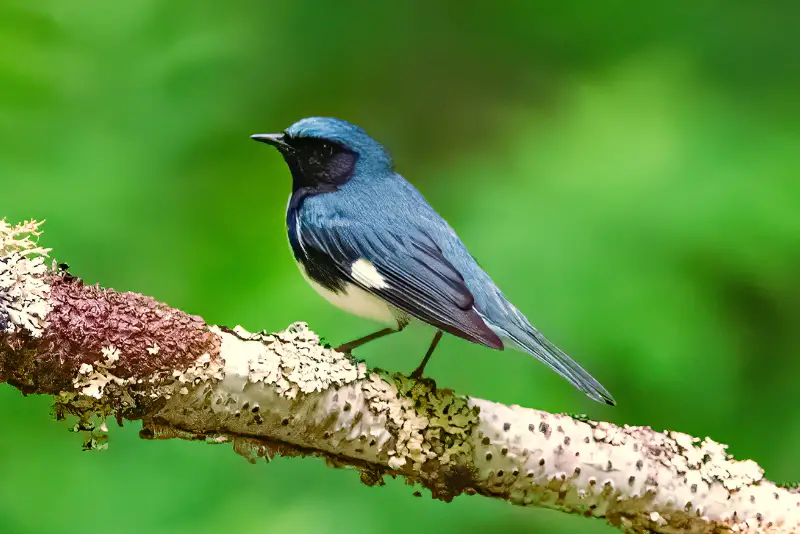
The male and female Black-throated Blue Warblers have plumages that are notably unlike one another.
During the summer, adult males have mostly dark blue upperparts, black wings, and a white spot at the base of the primary feathers on their wings.
There is a clear demarcation between the underparts and the upper parts, due to a line of black feathers.
In contrast to this, females and juvenile birds are grayish green on top, and pale yellow on the bottom.
During the months of May through August, this bird may be encountered nesting in the northern and central regions of North America.
It is a strict migratory bird, and spends the rest of its year in southern Florida and the Caribbean. These warblers feed on insects most of the year, but also include berries in their diet during fall.
Northern Parula
Scientific name: Setophaga americana
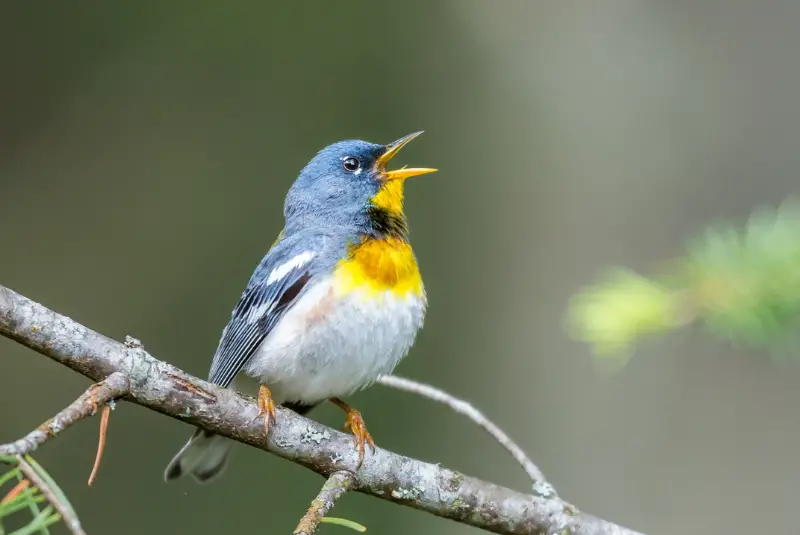
The Northern Parula is a colorful wood warbler that has distinct markings on its body.
The upperparts of adult males are mostly blue, and they have a yellowish green patch on the back, in addition to two white wing bars.
One of the most distinctive features is the bright yellow throat, as well as an orange breast band.
The eye of the Northern Parula has a partial white eyering, which is a great feature for identification of this little warbler.
This bird is a common summer visitor in Florida that can be seen in deciduous and mixed woodland. And although it is a migratory bird, some individuals can be seen year-round in southern Florida.
Blue-gray Gnatcatcher
Scientific name: Polioptila caerulea
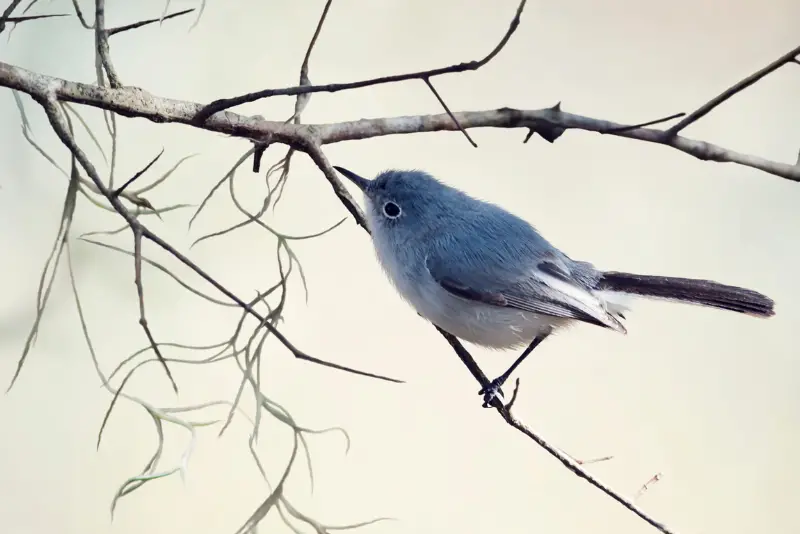
Except for its long tail, the Blue-gray Gnatcatcher looks a lot like a warbler.
The upperparts of adult males are blue-gray, while their underparts are a lighter gray. The tail is black with a white stripe at the margins.
Adult females and immature birds are rayish on top, and light gray underparts. The eye of both sexes has a white eyering.
It may be encountered as a breeding bird in the temperate regions of North America, predominantly from early May through August.
It is a partial migratory bird, with southeastern populations being year-round residents. Northern populations, however, spend the winter in the southern USA and Central America.
A great way to identify this bird is by its long tail that is often cocked upwards.
Tree Swallow
Scientific name: Tachycineta bicolor

It is a relatively common swallow in Florida, and is most often found close to lakes, marshes, and ponds.
Adult Tree Swallows are greenish blue on top, and have buff white underparts. Their feathers are iridescent, and change color when viewed in direct sunlight.
While adult females look similar to adult males, young birds are more grayish brown with a white underside.
This swallow readily accepts suitable nesting boxes, which gives you an opportunity to attract this attractive blue-colored bird in Florida to your backyard.
This blue bird feeds exclusively on insects that it catches in the air, and as a strict insectivore this bird is a long distance migrant that only spends the summer in Florida.
Tree Swallows winter around the Gulf of Mexico, as well as in Central America.
Purple Martin
Scientific name: Progne subis

The Purple Martin is the largest martin in North America. The male is almost entirely dark purplish blue with an iridescent sheen. The wings and tail are black.
Juvenile birds and females are light gray on top, with beige white underparts. The male Purple Martin is the only martin species that doesn’t have a light colored belly.
While these blue-colored birds originally built their nest in tree cavities, they have switched over to using man-made nesting sites instead.
The Purple Martin likes to nest in colonies, which often comprise dozens of pairs. It is a skilled aerial hunter, and feeds mostly on dragonflies.
Similar to other species of swallows, the Purple Martin drinks in flight, by skimming the surface of a body of water.
This bird is a strictly migratory species and spends the winter in South America. It congregates in large roosts in fall, which fly south together.
The best way to attract these gorgeous blue birds to your yard is by putting up a Purple Martin house in your backyard,
Belted Kingfisher
Scientific name: Megaceryle alcyon

The Belted Kingfisher looks superficially similar to a Blue Jay, due to its grayish blue upperside.
However, the Belted Kingfisher is darker than a Jay, and is also more likely to be found close to water.
Adult male Belted Kingfishers are almost entirely teal blue on top, except for a white collar that separates the cap from the rest of the body.
They also have a grayish chest band, and a white belly. Females can be distinguished from males by their rufous orange flanks.
The Belted Kingfisher prefers habitats directly adjacent to lakes and rivers, where it hunts for fish by diving headfirst into the water.
This blue bird is a partial migratory bird, but can be seen year round in southern parts of its range, including Florida.
During harsh winters, northern Belted Kingfishers migrate to southern parts of the United States.
This blue-colored bird of Florida feeds almost exclusively on small fish, and is therefore rarely seen far away from water.
Great Blue Heron
Scientific name: Ardea herodias
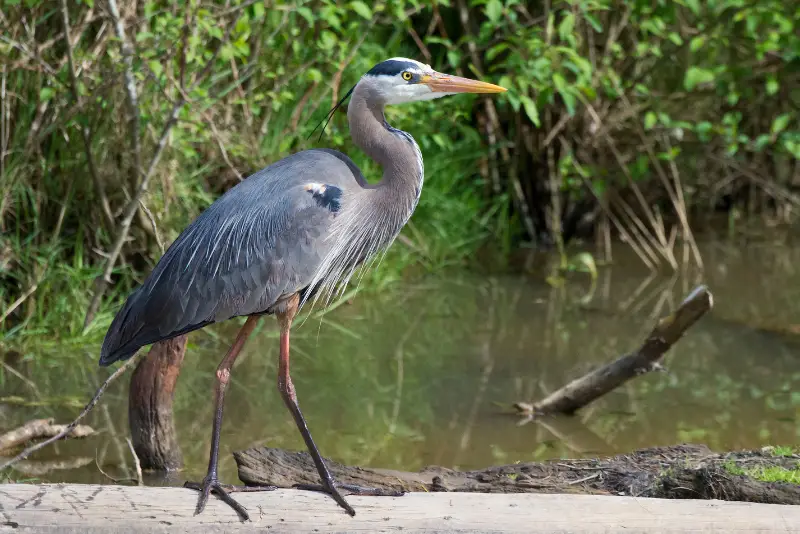
The Great Blue Heron is one of the most common herons in Florida, where it can be seen year round.
This bird likes to hunt for small fish by wading in the shallows of lakes, marshes and ponds.
This heron is a very large bird in Florida with a wingspan of up to 6 feet. It is almost entirely blue gray, except for a white throat and eye stripe, as well as dark gray wing feathers.
This bird waits patiently for a suitably sized fish to come close enough to be grabbed with its long, yellow bill.
This blue bird also forages on meadows, golf courses and grassy areas, where it stalks rodents. It is a non-migratory bird, and can be seen in Florida all year round.
However, it requires open water in order to catch fish, and northern birds will fly to southern states if the winter is very cold.
Little Blue Heron
Scientific name: Egretta caerulea
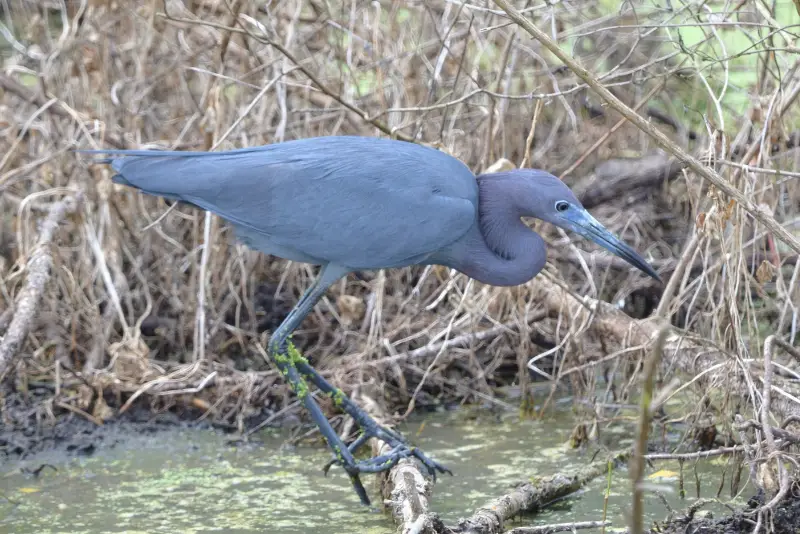
While adult Little Blue Herons are slate blue, young birds are entirely white during their first year.
Juvenile birds can be distinguished from other white herons by their dark bill and green legs.
These small herons are common breeding birds of Florida that can be seen year-round.
During winter, their numbers swell, due to an influx of birds from further north, which spend the winter months in Florida.
These birds feed on small fish, mollusks and crustaceans, with crayfish forming a large part of their diet.
They prefer an aquatic habitat, where these birds hunt in the shallows, and are rarely seen away from water.
Blue Grosbeak
Scientific name: Passerina caerulea

The Blue Grosbeak is a beautiful songbird that has a large beak that is shaped like a cone.
The adult males are almost entirely dark blue in color, except for two chestnut-brown wingbars and a black face.
Females, on the other hand, are brownish gray with pale underparts. This grosbeak is a breeding visitor in north Florida, but migrates to Central America to spend the winter.
The preferred habitat of this bird is shrubland and grassland interspersed with dense bushes.
Blue-winged Teal
Scientific name: Spatula discors

While this is not an entirely blue bird, adult males have a powdery blue forewing, as well as a dark green rear margin of the wing. This coloration is most clearly seen in flight.
These small ducks prefer marshland and ponds, and can be seen in saltwater and brackish water habitats outside of the breeding season.
They are regular winter visitors in Florida, but migrate to Canada and the northern USA during the summer.
Blue-headed Vireo
Scientific name: Vireo solitarius

The Blue-headed Vireo is a small songbird in which the two sexes look largely similar to each other.
Adult birds have a grayish blue hood, as well as an olive green back, white throat, and dark wings. A striking feature is the thick white eyering.
This bird is a year-round resident in Florida, where it breeds in a variety of woodland habitats.
During the winter months, there is an influx of northern individuals that spend the winter in Florida.
What are the small blue birds in Florida?
The only small bird in Florida that is entirely blue is the Indigo Bunting. This bird is a small finch species that likes to visit bird feeders offering seeds in spring.
During summer, male Indigo Buntings can be heard singing at the top of their voices from treetops.
The other small bird in Florida that is mostly blue is the Eastern Bluebird, but this blue-colored bird can be readily distinguished from the Indigo Bunting by its rufous orange chest and belly.
